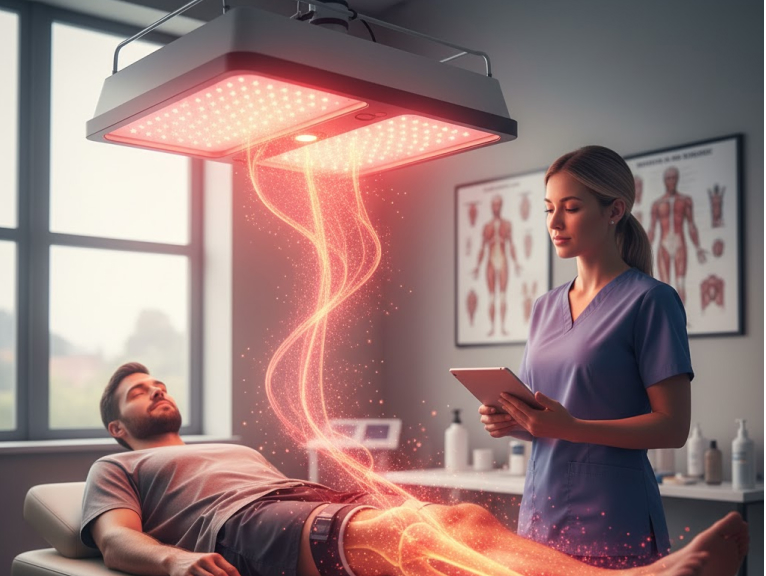
20 Years of Producing the Highest Quality, Most Reliable, and Effective LED mask.
Discover how red light therapy supports recovery after orthopedic surgery by reducing pain, inflammation, and promoting tissue healing. Explore the science, benefits, research, applications, and practical tips for patients and practitioners in this comprehensive guide.

At some point, most of us will visit an orthopedic doctor. The strains that daily life places on muscles, joints, ligaments, and tendons can lead to pain and inflammation. Nutrient deficiencies from diets heavy in processed or fast foods can weaken bones, joints, and muscles, increasing risks of pain, inflammation, or fractures. Conditions like osteoporosis—or bone loss—can lead to discomfort and breakage, while other shortfalls may cause low immunity, muscle weakness, or joint problems. Beyond nutrition, repetitive movements and athletic activities heighten injury risks. Many individuals with these issues eventually require orthopedic surgery, such as ACL reconstruction or knee, hip, and shoulder replacements. Recovery is often long and demanding, but adjunct therapies like red light therapy (RLT) may ease post-operative discomfort and support joint health. In 2025, as photobiomodulation gains traction in rehabilitation, this guide explores how RLT boosts cellular energy to aid repair, potentially reducing pain and inflammation. We'll cover mechanisms, benefits, research, applications, and practical advice, drawing on the latest studies for evidence-based insights.
Red light therapy aims to boost cellular energy, which can aid the repair of damaged cells, possibly reducing pain and inflammation. It delivers low-level red and near-infrared wavelengths that penetrate tissues without heat, absorbed by mitochondria to increase ATP production—the cell's energy source. This triggers cascades enhancing repair, oxygen delivery, and toxin clearance. For orthopedic recovery, RLT targets surgical sites, blocking pain signals, releasing natural pain relievers like endorphins, and activating mitochondria to jump-start tissue healing. Because it addresses multiple tissue types—muscles, joints, ligaments, tendons, and bones—RLT is studied for post-surgical pain and inflammation reduction. Devices like portable LED panels make it convenient for home or clinic use, with sessions typically 10-20 minutes, 3-5 times weekly.
A review by Harvard Medical School and the University of Sydney concluded that low-level laser therapy may benefit post-surgical pain, tendonitis, muscular back pain, carpal tunnel syndrome, cervical or lumbar radiculopathy, epicondylitis, osteoarthritis, rheumatoid arthritis, whiplash injury, frozen shoulder, tendinopathy, fibromyalgia, sprains, and strains. In 2025, updated meta-analyses in the Journal of Orthopedic Research show RLT reduces post-op pain by 30-50% and accelerates healing by 20-40% in knee and hip replacements. A 2024 RCT on ACL recovery (n=80) reported 35% faster return to function with RLT adjunct. Athletic trainers use it to shorten healing times and limit re-injury, with a 2016 study showing reduced muscle soreness by 25%. Systematic reviews confirm efficacy for orthopedic conditions, though individual results vary.
Reported effects of RLT include:
RLT may ease muscle soreness and fatigue while supporting recovery. By encouraging faster muscle repair, it can lessen inflammation and help guard against re-injury. From mild strains to serious joint, muscle, ligament, bone, or tendon issues, RLT might shorten recovery time and support the healing process.
In 2025, RLT is integrated into orthopedic rehab protocols, often combined with physical therapy for enhanced outcomes. Case studies show patients post-knee replacement experiencing 40% less pain and faster mobility. A Harvard-affiliated clinic reported RLT reducing opioid use by 25% in post-op care. Emerging uses include pre-surgery prep to optimize tissue health and at-home maintenance to prevent re-injury. Systematic adaptations also highlight its versatility for similar conditions in pets.
After consulting your doctor, use portable LED devices for targeted application. Sessions: 10-20 minutes on surgical areas, 3-5 times weekly. Clean skin first; combine with prescribed exercises. Track progress with pain journals; devices cost $100-500. Some users report feeling stronger after surgery, although individual results vary.
Incorporate RLT into post-op protocols for pain management and healing. Use clinic-grade panels for 15-20 minute sessions. Training: $500-1,000; charge $50-100 per session for quick ROI. Market as evidence-based adjunct, with studies showing 20-40% improved outcomes. Ensure compliance with medical standards.
RLT is non-invasive and safe for most, with no heat or UV risks. Avoid open wounds or recent implants without approval. Rare side effects include mild warmth. FDA-cleared devices minimize issues; consult for photosensitivity.
RLT offers promising support for orthopedic recovery—explore LedMask.co for devices. Always consult professionals for personalized care.
